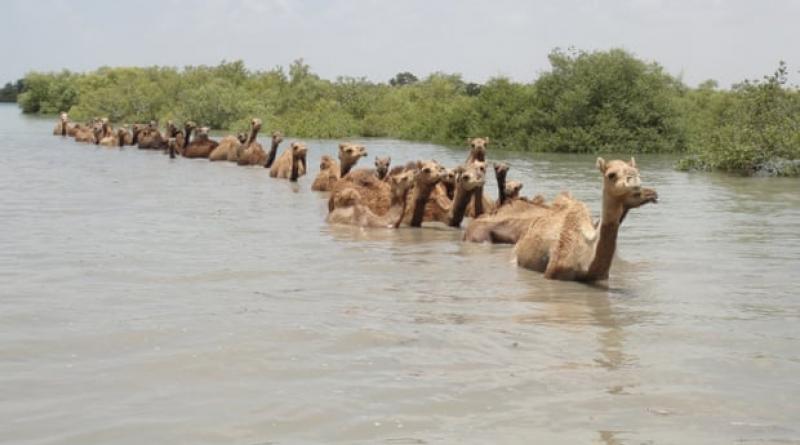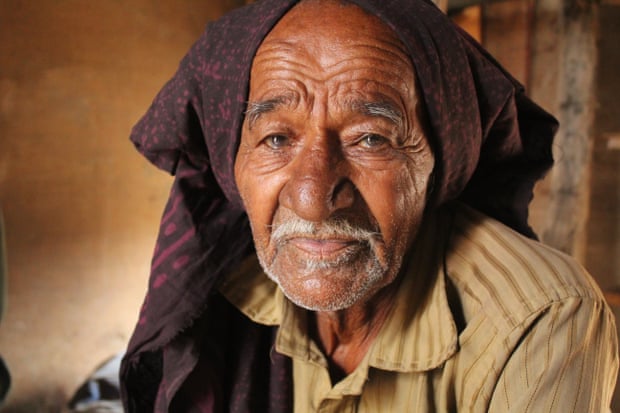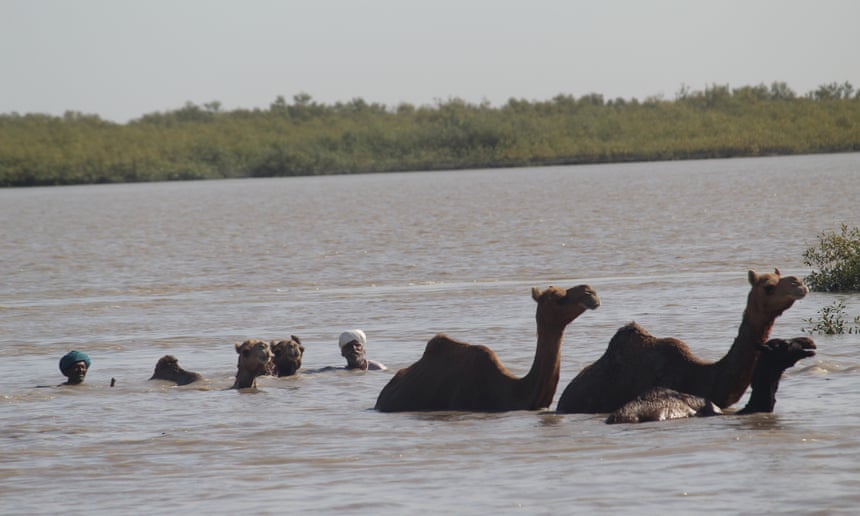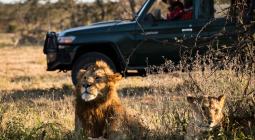High and dry: will India's swimming camels be the last of their kind?

Rapid industrialisation in Gujarat threatens the mangroves that kharai camels and their nomadic herders depend on.
Ayub Amin Jat treats his camels like his children. But then his camels are no ordinary ungulates: they are a unique breed of camels that swim.
Amin Jat’s semi-nomadic ancestors have kept these camels in the Indian state of Gujarat for hundreds of years. Known as kharai camels, their name is derived from the local word khara, meaning saline. During the rainy season, they swim along the Gulf of Kutch, an inlet of the Arabian Sea, to small forest islands and graze on mangroves and other saline-loving plants.
Their gently padded hooves help them navigate the wet and salty coastal land with ease and they can swim up to three kilometres (1.8 miles). Immediately after grazing, they drink the rainwater collected in the depressions of the islands. When there isn’t enough water, the herders take them to neighbouring villages to feed them.
But kharai camels are disappearing. Although exact numbers are hard to find – kharai camels were only recognised as a separate breed in 2015 – local nonprofit Sahjeevan estimates that there were more than 10,000 in Gujarat about a decade ago. Now there are fewer than 4,500. Rapid industrialisation in the mangrove swamps and erratic rainfall are destroying the habitat kharai camels rely on for food, and pushing this unique breed to extinction, warn conservationists.
“My ancestors gave me these camels,” says Amin Jat, 53. “They are like my kids. How can I see them die in front of my eyes?”

Herders and local conservationists point to the activities of the many salt companies in the mangrove swamps. The companies create salt pans by restricting the entry of tidal water in the mangroves. This dries up the plants and eventually kills them. Power plants, ports and other industries are also responsible for the loss of the camels’ habitat, Sahjeevan says.
“These companies create mud walls, locally known as bunds, around a portion of land which blocks the tidal water. Without the water, the mangroves die a slow death, making it easier for the machines to uproot them,” says Mahendra Bhanani, camel programme coordinator at Sahjeevan. “One company plundered over 4 sq km of mangrove cover for over a month like this in 2018.”
The salt companies argue that they bring development and jobs to an area that is nothing more than wasteland. “The land allotted to us is saline wasteland, on which nothing can grow,” says Bharat Raval, president of the Indian Salt Manufacturers’ Association, which represents more than 60 companies. “There may be a few defaulters but they are very small in number.”
G A Thivakaran, a scientist at Gujarat Institute of Desert Ecology who specialises in coastal and marine ecology, says that some companies have been going out of their way to get land declared wasteland. “Until about two decades ago, industries were rampantly destroying mangroves. In 2011, the government framed stricter laws and limited development in mangrove areas. But then the companies found a new workaround. They would block the tidal creek, leading the mangrove to die a natural death in about a year. The land would then be declared a wasteland and [could] easily be claimed by industries,” he says.
The Indian government has taken notice of the camels’ decline and in 2015 designated them endangered. “Health camps” for the camels were set up, and nonprofit organisations were given funds to provide breeding and veterinary support to herders.

In September last year, herders also won a reprieve from India’s National Green Tribunal, which handles environmental disputes. It asked the Gujarat authorities to check any kind of obstruction in the flow of tidal creeks, and restore mangroves. It also warned against any kind of salt manufacturing activity in certain areas.
But herders say their fight to protect the mangroves is ongoing. “It’s a constant struggle. We get one company removed, another one comes up within a week,” says Bhanani. “It’s like perpetual hide-and-seek.”
According to India’s forest department, the mangrove cover in Gujarat has, in fact, risen from 1,140 sq km in 2017 to 1,177 sq km in 2019.
But the camels are not allowed to graze on the department-owned land, Amin Jat says. “The animal husbandry land is being allotted to companies and the forest department people shoo us away from their land. Where do we go?”
Thivakaran says that while the camels trample on the plants, they cannot be held responsible for the depletion of the mangrove cover. “It’s the industries [that are responsible]. Camels and mangroves have coexisted for generations. Moreover, kharai camels mostly graze on sparse or degraded mangroves.”
Erratic rainfall in the region compounds the problem. Kutch has a variable rainfall and is hit by drought about every three years. “Because of the salt content in the mangroves, the camels immediately need to drink water after grazing. So low rainfall spells a crisis for us,” says Amin Jat. “We don’t need big buildings. We just need food and clean water for our animals.”
Local nonprofits have been lobbying hard against increasing industrialisation in the area but are also working to persuade herders to start selling camel milk as a source of income.
Traditionally the community has been averse to the idea of selling camel milk or wool. According to Amin Jat, a revered spiritual leader once discouraged the practice and advised herders to give away the products to anyone who asks. “But of late, many people have started selling the milk to sustain themselves,” he says, sitting in his wooden hut in a village in Kutch as his nephew, Hamir Bhachu Jat, serves us camel milk tea in wide-mouthed steel bowls.
Local people believe that the milk of kharai camels is beneficial in the treatment of tuberculosis, diabetes and cancer. “Our people don’t get any major diseases,” Bhachu Jat says. “This milk is medicinal. My uncle sometimes goes without food for as many as five days during his trips to the islands, only surviving on camel milk.”
Amin Jat has never had a permanent home. His family typically moves three times a year in search of grazing grounds for their camels. He belongs to the pastoralist community of Fakirani Jats, whose primary occupation has traditionally been camel breeding. Wherever they settle, the women of the family build houses made of reed grass, jute ropes and wood called pakkhas. They mostly use camels to carry their belongings during their migratory tours but, occasionally, sell off a male camel to sustain them through several months.

But Amin Jat is not optimistic about the future. “If they don’t stop the industries soon, I will send my camels to a slaughterhouse,” he says.
“The camels’ extinction would not just be an ecological loss but also a cultural one,” Bhanani laments. “It would fundamentally alter the pastoral lifestyle of the Fakirani Jats and other nomadic communities in the region. Younger male members in their families are migrating to cities and seeking jobs to sustain themselves. Interestingly, some are employed by the same companies that are destroying their camels’ habitat.”
Find more age of extinction coverage here, and follow biodiversity reporters Phoebe Weston and Patrick Greenfield on Twitter for all the latest news and features
3 October 2020
The Guardian




